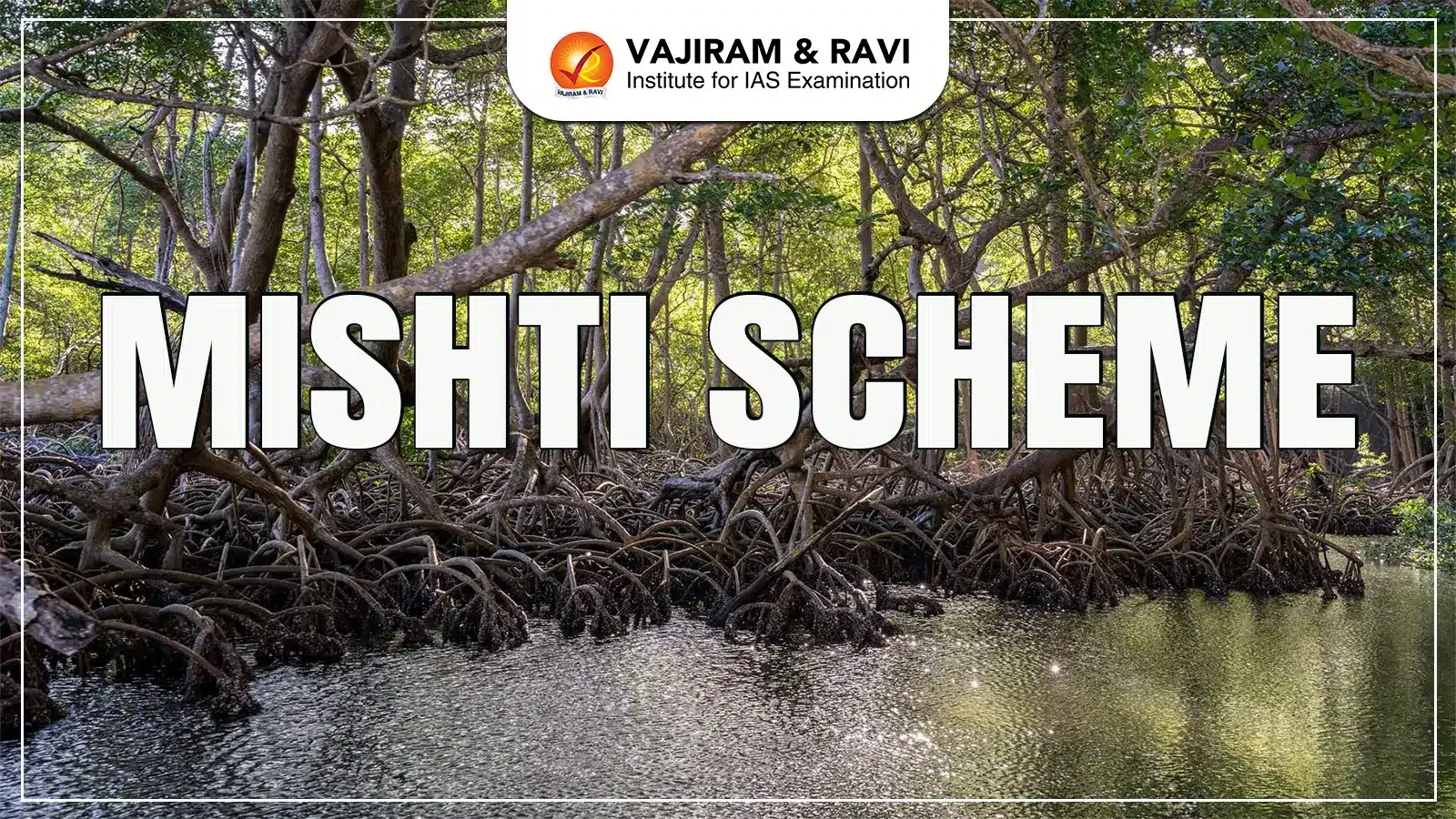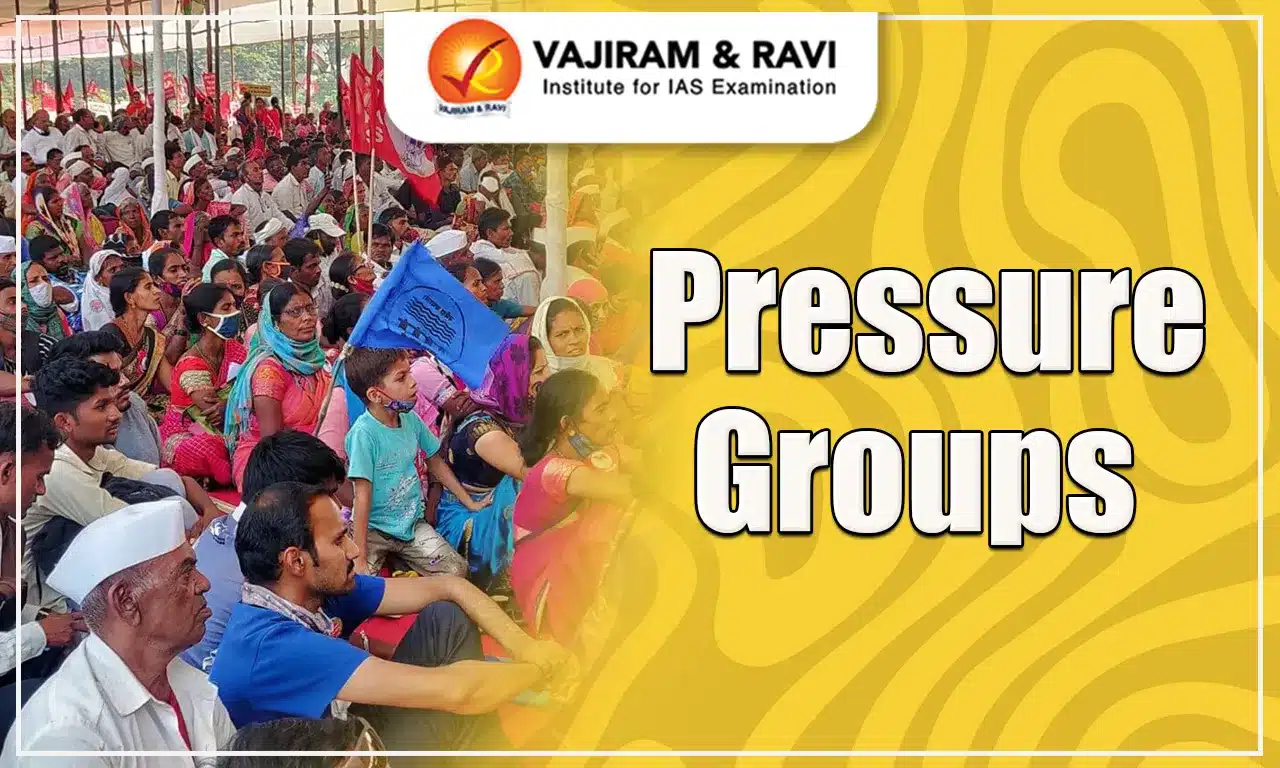MISHTI (Mangrove Initiative for Shoreline Habitats & Tangible Incomes) Scheme, launched in 2023, focuses on restoring and conserving mangrove ecosystems across 11 states and 2 Union Territories. It aims to promote ecological benefits like carbon sequestration and enhance coastal resilience against climate change impacts such as sea-level rise.
MISHTI is funded through a convergence of resources from CAMPA, MGNREGS, and other government programs. The scheme actively involves local communities in conservation efforts, providing economic benefits through the sustainable use of mangroves. It also fosters public-private partnerships to mobilize resources, aligning with India's commitments to the Paris Agreement and UN SDGs.
MISHTI Scheme Overview
MISHTI (Mangrove Initiative for Shoreline Habitats & Tangible Incomes) scheme, launched in 2023 under India's New India 2030 vision, aims to promote sustainability in coastal ecosystems like mangroves, seagrasses, and coral reefs. The Ministry of Environment, Forest, and Climate Change announced it in the Union Budget FY 2023-24.
MISHTI focuses on conserving Mangroves for their ecological benefits, including high biological productivity and carbon sequestration. It addresses climate change, supporting the green energy transition and economy. It follows India's participation in the Mangrove Alliance for Climate, introduced at COP27 (Egypt, 2022) of the UN Framework Convention on Climate Change.
MISHTI Scheme Vision
To enhance the resilience of the Indian coast and ensure the protection of coastal life, livelihood and infrastructure against climate change consequences such as sea-level rise through conservation and management of coastal habitats.
MISHTI Scheme Aim
MISHTI Scheme aims to restore mangrove forests along India’s coastline through reforestation and afforestation measures, adopting best practices from both India and around the world.
MISHTI Scheme Objectives
The key objectives of the MISHTI scheme include the convergence of resources from the CAMPA Fund, MGNREGS, and other schemes for effective implementation. It targets specific areas for mangrove restoration, such as degraded or gap areas, mudflats with historical mangroves, abandoned aquaculture ponds, and salt pans.
- Additionally, the scheme focuses on rehabilitating areas infested with invasive species, where there is potential for mangrove growth, ensuring comprehensive ecosystem recovery.
MISHTI Scheme Geographical Coverage
MISHTI scheme targets the restoration of approximately 540 sq km of mangrove habitats over five years (2023-2028). It is being implemented across 11 states—including West Bengal, Gujarat, Odisha, Andhra Pradesh, Tamil Nadu, Kerala, Maharashtra, Karnataka, Goa, Uttar Pradesh, and Telangana—and 2 Union Territories, namely the Andaman & Nicobar Islands and Lakshadweep.
MISHTI Scheme Key Stakeholders
MISHTI Scheme involves multiple levels of governance to ensure effective implementation and coordination. The key stakeholders operate at the national, state, and district levels to oversee the restoration and conservation efforts.
- National Level: The Green India Mission Directorate acts as the National Implementing Agency.
- State Level: The State Forest Departments and State MISHTI Cells oversee operations at the state level.
- District Level: The District MISHTI Cells, led by District Collectors, manage implementation at the local level.
MISHTI Scheme Implementation Strategy
MISHTI Scheme will follow the Nagar Van Yojana model for funding, implementation, and monitoring. The State Forest Department will oversee the implementation of the program:
- Targets: Restoration of mangroves on both forest and non-forest land will be taken up under State CAMPA (Compensatory Afforestation Fund Management and Planning Authority) through the NPV (Net Present Value) component, National CAMPA, and MGNREGS.
- Financial Convergence: The MISHTI program will be funded through:
- MGNREGS (Mahatma Gandhi National Rural Employment Guarantee Scheme) and other sources for about 30%.
- CAMPA for around 70% of the financial allocation.
MISHTI Scheme Benefits
MISHTI Scheme promotes sustainable management and restoration of mangrove habitats, enhancing coastal ecosystem health and biodiversity. It engages local communities, boosts livelihoods, and leverages coordinated resources, aligning with India’s climate goals and international commitments.
- Sustainable Management: Promotes conservation and restoration of mangrove habitats, critical for coastal ecosystem health and biodiversity.
- It supports India’s commitments under the Paris Agreement & UN SDGs.
- Economic Benefits: Provides financial gains to local communities through the sustainable use of mangroves and related ecosystems.
- Enhances livelihoods for coastal communities by offering income-generating opportunities.
- Community Involvement: Engages local communities in conservation efforts, fostering ownership and active participation in mangrove management and restoration.
- Strengthens coastal communities' resilience to climate impacts, such as sea-level rise and storm surges.
- Coordinated Resource Utilization: Utilizes the convergence of Central and State Government schemes for efficient and effective implementation of the scheme.
- Gujarat leads in MISHTI implementation, planting 19,020 hectares of mangroves with Rs 76 crore investment in 2 years, leveraging public-private partnerships and strict policy adherence for effective coastal conservation and sustainability.
MISHTI Scheme Challenges
MISHTI scheme aims to restore and conserve mangrove ecosystems but faces significant challenges. These include the threat of sea level rise, soil salinity, inadequate funding, and issues in policy enforcement, which hinder mangrove regeneration efforts.
- Sea Level Rise: Rising sea levels due to climate change can inundate mangrove areas, making it difficult for mangroves to survive and thrive.
- For example, Kerala has lost around 95% of its mangrove forests in the last three decades.
- Soil Salinity and Sedimentation: High soil salinity and changes in sedimentation patterns can affect mangrove growth and survival.
- Mangroves require specific soil conditions to thrive, and disturbances in these conditions can hinder their development.
- Inadequate Funding: Restoration projects require substantial funding and long-term commitment.
- While the scheme leverages funds from sources like CAMPA and MGNREGA, the overall funding may still be insufficient to meet the ambitious targets.
- Policy and Regulatory Framework: Ensuring that existing policies and regulations are effectively implemented and enforced is crucial.
- For example, the Coastal Regulation Zone (CRZ) Notification (2019) and other relevant acts must be strictly adhered to.
MISHTI Scheme Way Forward
To ensure the success of the MISHTI scheme, a multi-pronged approach is needed, including strict policy enforcement, participatory land use planning, and community engagement. Strengthening public-private partnerships and promoting eco-tourism can provide sustainable funding while enhancing local socio-economic benefits.
- Policy and Regulatory Framework: Ensure strict adherence to existing policies and regulations, such as the Coastal Regulation Zone (CRZ) Notification (2019), to protect mangrove habitats from conversion to other uses.
- Land Use Planning: Implement land use planning and management in a participatory manner to ensure that land identified for mangrove plantations is not used for other purposes.
- Community Mobilization: To sensitize local communities about the importance of mangrove forests and the benefits of the MISHTI scheme.
- Promotion of Eco-tourism: To generate additional revenue for local communities, thereby enhancing their socio-economic conditions.
- Public-Private Partnerships: To mobilize additional funding for the implementation of the scheme.
Last updated on November, 2025
→ Check out the latest UPSC Syllabus 2026 here.
→ Join Vajiram & Ravi’s Interview Guidance Programme for expert help to crack your final UPSC stage.
→ UPSC Mains Result 2025 is now out.
→ UPSC Notification 2026 is scheduled to be released on January 14, 2026.
→ UPSC Calendar 2026 is released on 15th May, 2025.
→ The UPSC Vacancy 2025 were released 1129, out of which 979 were for UPSC CSE and remaining 150 are for UPSC IFoS.
→ UPSC Prelims 2026 will be conducted on 24th May, 2026 & UPSC Mains 2026 will be conducted on 21st August 2026.
→ The UPSC Selection Process is of 3 stages-Prelims, Mains and Interview.
→ UPSC Result 2024 is released with latest UPSC Marksheet 2024. Check Now!
→ UPSC Prelims Result 2025 is out now for the CSE held on 25 May 2025.
→ UPSC Toppers List 2024 is released now. Shakti Dubey is UPSC AIR 1 2024 Topper.
→ UPSC Prelims Question Paper 2025 and Unofficial Prelims Answer Key 2025 are available now.
→ UPSC Mains Question Paper 2025 is out for Essay, GS 1, 2, 3 & GS 4.
→ UPSC Mains Indian Language Question Paper 2025 is now out.
→ UPSC Mains Optional Question Paper 2025 is now out.
→ Also check Best IAS Coaching in Delhi
MISHTI Scheme FAQs
Q1. What is the MISHTI program?+
Q2. What is the MISHTI scheme launched for?+
Q3. Is MISHTI a central sector scheme?+
Q4. How long is the MISHTI scheme?+
Q5. Which ministry launched the MISHTI scheme?+
Tags: mishti scheme quest UPSC Environment and Ecology Notes

















